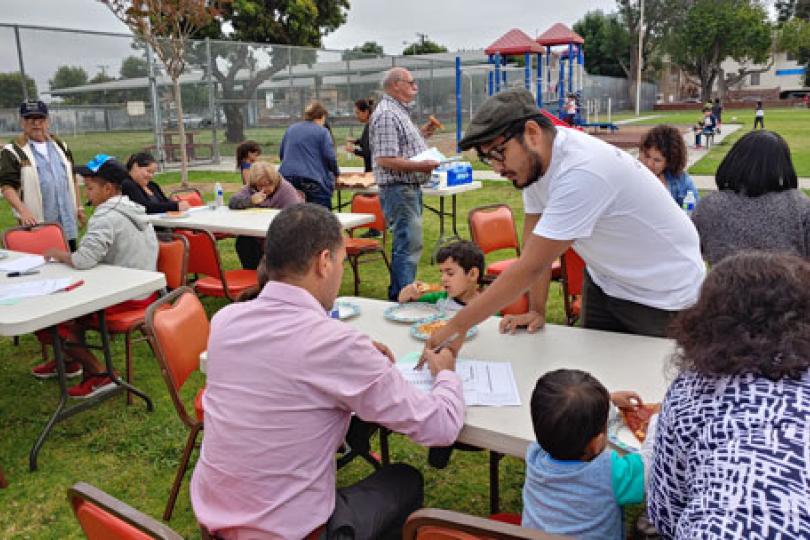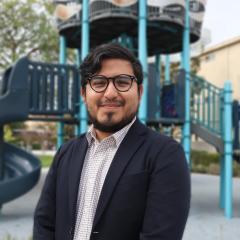José Guadalupe Gutierrez: Designing Green Spaces for Equity and Community
When Switzer Fellow José Guadalupe Gutierrez would visit family in Jalisco, Mexico, as a kid, he was “surrounded by open pastures where we could have a family picnic, pick mushrooms and cactus fruit early in the morning, and learn about the landscape.” Returning to his home of Los Angeles, he and his friends would play on the train tracks because there was no access to safe, quality parks near his home; a situation that many working class kids of color across the city and the country experience.
Later, working as an organizer for parks and gardens in communities of color across Los Angeles and Riverside, José “grew close to many of the park residents and community gardeners I had the privilege of working with. They came from many backgrounds: African Americans with their roots in the south, Mexicans, Central Americans, Pilipinos, Muslims, Tongans, Koreans — all united in their love of gardening and in their struggles as working people with no places to relax after an arduous work day.”
These experiences informed José’s belief that everyone deserves to live within walking distance of quality greenspace. Green spaces such as parks and gardens can provide communities with “safe, open areas for people to lower their blood pressures, play, cook, garden, organize, and build community.”
After succeeding in “passing — and defending — equitable park funding measures alongside community members”, José realized “millions of dollars for new parks were on the horizon, and that landscape architects — with their tools and knowledge — were the best equipped to take on these new, meaningful projects. I then saw a career in landscape architecture as the next phase in my work to advance park equity.”
In graduate school, José was surprised to learn that community organizing and landscape architecture have been “wedded together for many decades.” In order to create successful, equitable projects that are “responsive to the needs and interests of people”, landscape architects “have a responsibility to implement robust, authentic organizing strategies for the greenspaces we design and construct. Residents must be involved in every step of the way, especially in complex greenspace projects such as those that are brownfields, superfund sites, and projects where residents have many competing visions for the space.”
Since completing his Master of Landscape Architecture program with a Switzer Fellowship, José has worked on design for park construction projects with Dake Landscape, “a small Los Angeles-based landscape architecture firm headed by Glen Dake: a mentor and leader in LA’s park equity movement.” He is now starting an exciting new role as a park and recreation planner and landscape designer at MIG, to work on park development and planning, and “green schoolyards, a new and important frontier in the fight for park equity in communities of color.”
Read on for the full interview with José, and visit his Switzer profile here.
Switzer Foundation: Tell us about the work you’re doing these days.
José Guadalupe Gutierrez: These days I have been working as a landscape architecture professional focused on park construction and design. Upon finishing my Master of Landscape Architecture program in 2021, I took on a role as a landscape designer with Dake Landscape, a small Los Angeles-based landscape architecture firm headed by Glen Dake who is a mentor and leader in LA’s park equity movement. Our work focused on park and recreation planning, design, and construction along with robust community engagement around the creation of new parks and open spaces. As a designer, I was tasked with supporting the construction document development process, creating site plans and renderings for our park and open space projects, and preparing planting plans and project proposals.
Since most of my career in park planning has focused on the community organizing aspect of the work, my time at Dake Landscape provided an opportunity to learn about the technical aspects of park design and construction. It prepared me for a new and exciting role as a park and recreation planner and landscape designer with MIG, a multidisciplinary firm that does everything from park planning to wetland restoration. At MIG I will be working on park development projects, master planning, and even green schoolyards, a new and important frontier in the fight for park equity in communities of color.
When did you first become passionate about greenspaces?
José: I started my park equity journey as an organizer for parks and gardens in communities of color across Los Angeles and Riverside. Over the years I grew close to many of the park residents and community gardeners I had the privilege of working with. They came from many backgrounds: African Americans with their roots in the south, Mexicans, Central Americans, Pilipinos, Muslims, Tongans, Koreans — all united in their love of gardening and in their struggles as working people with no places to relax after an arduous work day. The parks and gardens I oversaw during my time at From Lot to Spot and the Los Angeles Neighborhood Land Trust were lifelines for all of the folks I worked with. Many lived in hot, crowded apartment buildings with pools that had been cemented over and noise restrictions. Many suffered from diabetes, high blood pressure, asthma, and were the first and worst impacted by COVID-19. Our parks provided safe, open areas for people to lower their blood pressures, play, cook, garden, organize, and build community. Closing our parks or gardens even for one day could upend the daily schedules of the community members we worked with — that was how embedded our greenspaces were in the day-to-day lives of their users. It was the residents’ commitment to the parks and gardens we managed that convinced me that park equity would be the focus of my work moving forward.
How did your experience with greenspaces while visiting family and friends in Mexico differ from your experiences growing up in Los Angeles?
José: I spent a significant portion of my youth in the highlands of the Mexican state of Jalisco. Our town, Valle de Guadalupe, was surrounded by open pastures where we could go have a family picnic, pick mushrooms and cactus fruit early in the morning, and learn about the landscape. Kids can play in the streets well into the night because there is barely any traffic passing through. It was always a disappointment having to come back to Los Angeles as a kid because there were no quality parks near my home. Those that did exist were too far or too dangerous to visit alone in the late 90s-early 2000s. So my friends and I played on the train tracks by my house. My cousins in Inglewood played in the Forum parking lot. Once I got involved in park work in my early 20s I realized the conditions I grew up in were not unique; kids from working communities of color across the city — and across the country — do not have access to quality, safe parks to play in.
How did your experience community organizing lead you to become a landscape architect?
José: Design and plants always caught my attention. This interest only increased as our Land Trust project managers talked to me about the two topics. I realized that I wanted to be a landscape architect right around the time we completed our park equity organizing campaigns at the Land Trust. Now that we had succeeded in passing — and defending — equitable park funding measures alongside community members, it came to me that millions of dollars for new parks were on the horizon, and that landscape architects — with their tools and knowledge — were the best equipped to take on these new, meaningful projects. I then saw a career in landscape architecture as the next phase in my work to advance park equity.
How can these two disciplines work together to create more equitable access to greenspaces?
José: I was surprised to find out in graduate school that community organizing and landscape architecture have been wedded together for so many decades. Landscape architecture is a profession tied closely with urban planning, and I think many of the misguided approaches to planning exercised throughout the 20th century were taken on by landscape architects as well. As an organizer, I think landscape architects then would often rely on the lowest hanging fruits in terms of strategies for engaging residents in the design process.
Presently, we in landscape architecture have a responsibility to implement robust, authentic organizing strategies for the greenspaces we design and construct. In the end these become the most successful, high quality projects because they are responsive to the needs and interests of people. We cannot go back to planning and designing parks from the top-down. Residents must be involved in every step of the way, especially in complex greenspace projects such as those that are brownfields, superfund sites, and projects where residents have many competing visions for what the greenspace should look like.
What’s one of your proudest achievements doing this work? What has been a challenge?
José: One of my proudest achievements has been the passing of equity based park funding measures during my time at the Land Trust. Working alongside the residents who use our parks and gardens, we succeeded in passing an update to LA city’s quimby ordinance, which funds the development of new park projects; we passed LA County’s Measure A, which dedicates a percentage of the funds for projects in areas of high and very high need of parks; and we passed Proposition 68, the state measure which provided millions of dollars for park projects across California.
A big challenge has been making sure residents are kept engaged in the park equity work, especially since many of these park projects take a long time to build and open.
What impact has the Switzer Fellowship had on you?
José: The Switzer Fellowship gave me a stronger appreciation for policy work, and made me think more critically about why the park equity policy work was so important to achieving our local goals at the Land Trust to expand access to parks across the county. The Switzer Fellowship also gave me the opportunity to complete my last two years of the MLA program, and the Switzer Foundation has provided me numerous professional development opportunities that have really supported my growth as an organizer and landscape architecture professional.
Is there anything else you’d like to share?
José: One aspect of our work in both organizing and landscape architecture that I am excited about is the work around green schoolyards. The topic has gained a lot of attention these last few years in Los Angeles and across the country. Green schoolyards will allow us to significantly expand park access across Los Angeles, a city with little space left for development. I am looking forward to this work, which I will be taking on at MIG, and look forward to sharing updates with the Switzer Network.
The header photo is an image of José working on community engagement for the renovation of Zela Davis Park in Hawthorne. They were in the process of submitting the project for a State proposition 68 grant, and were working with residents to design the upgrades.

